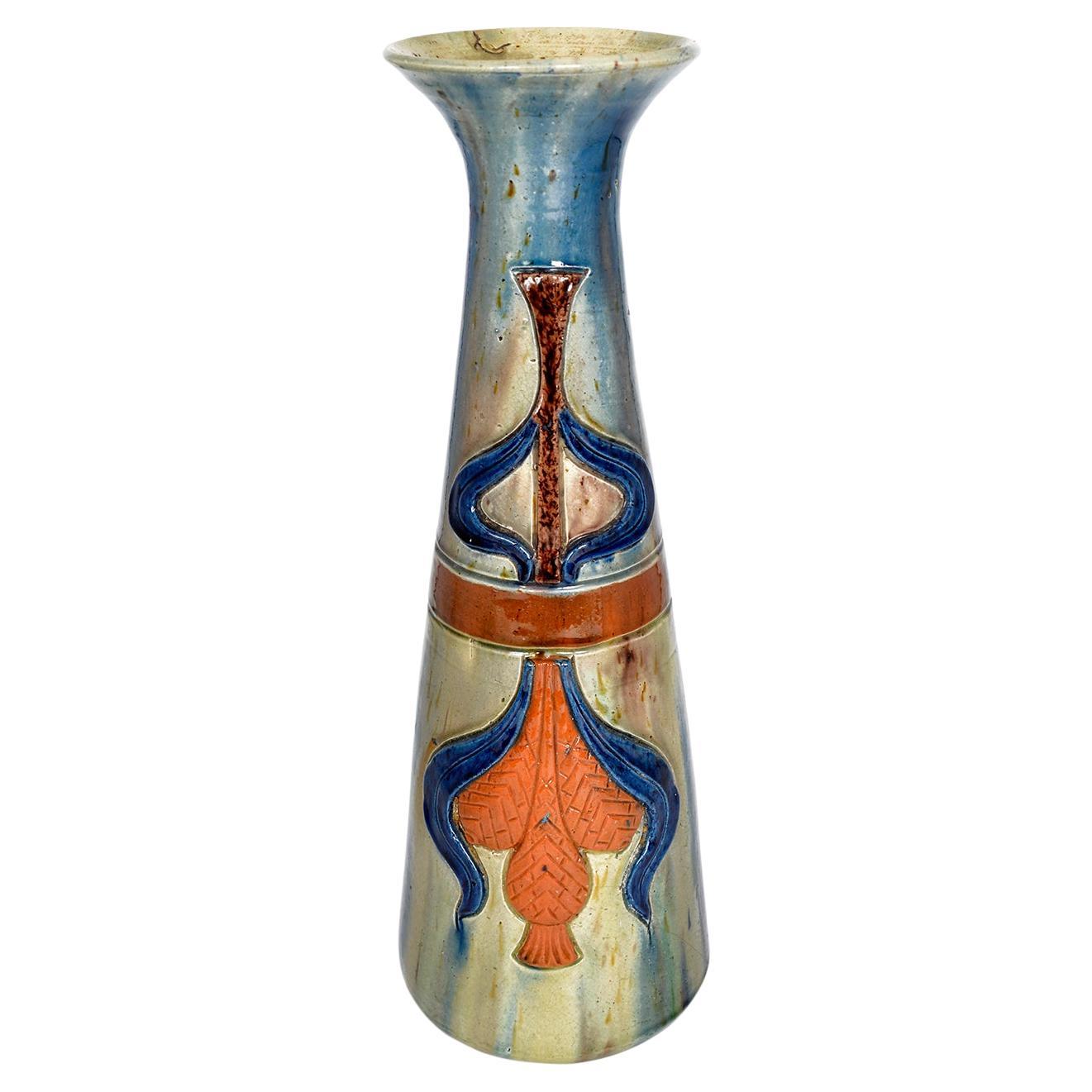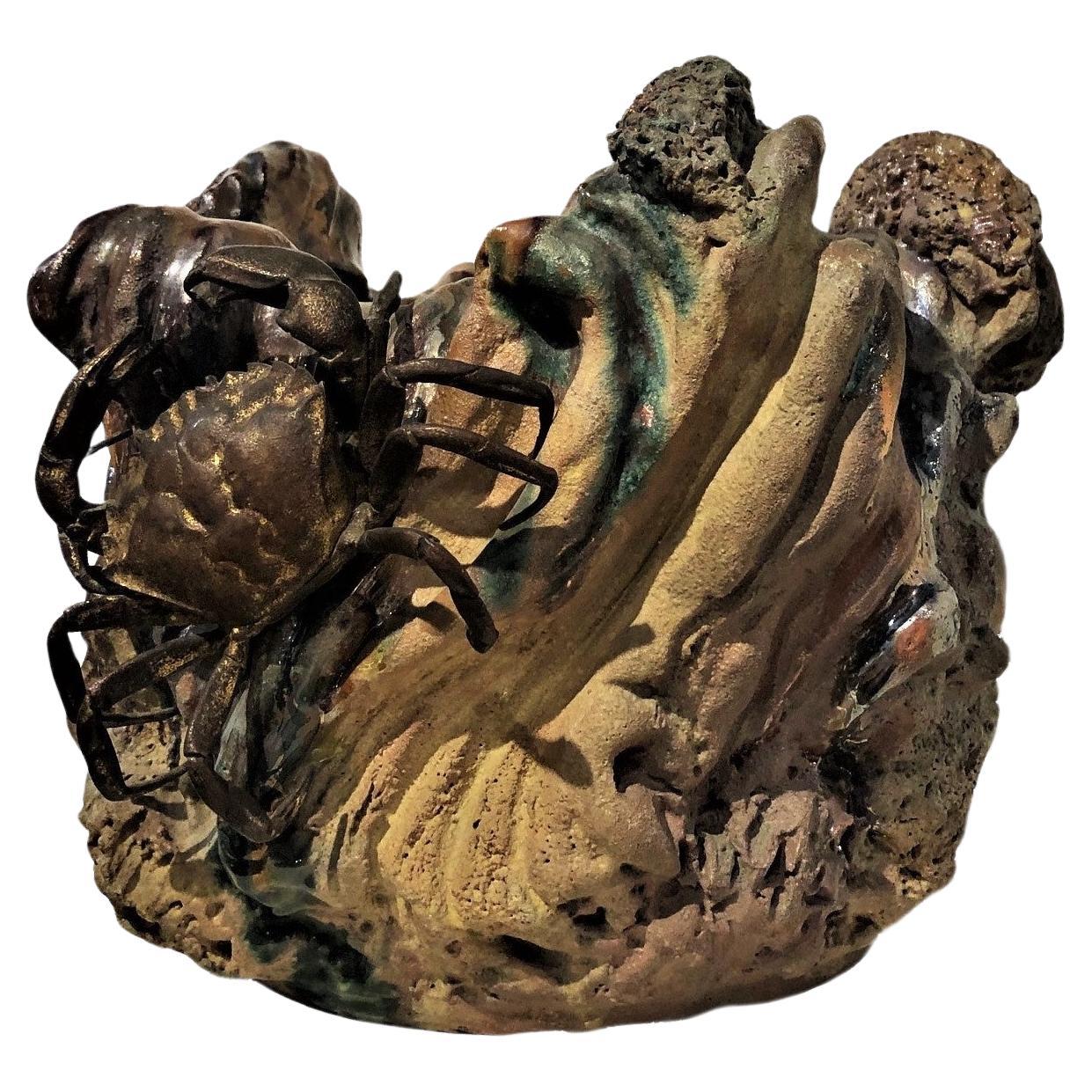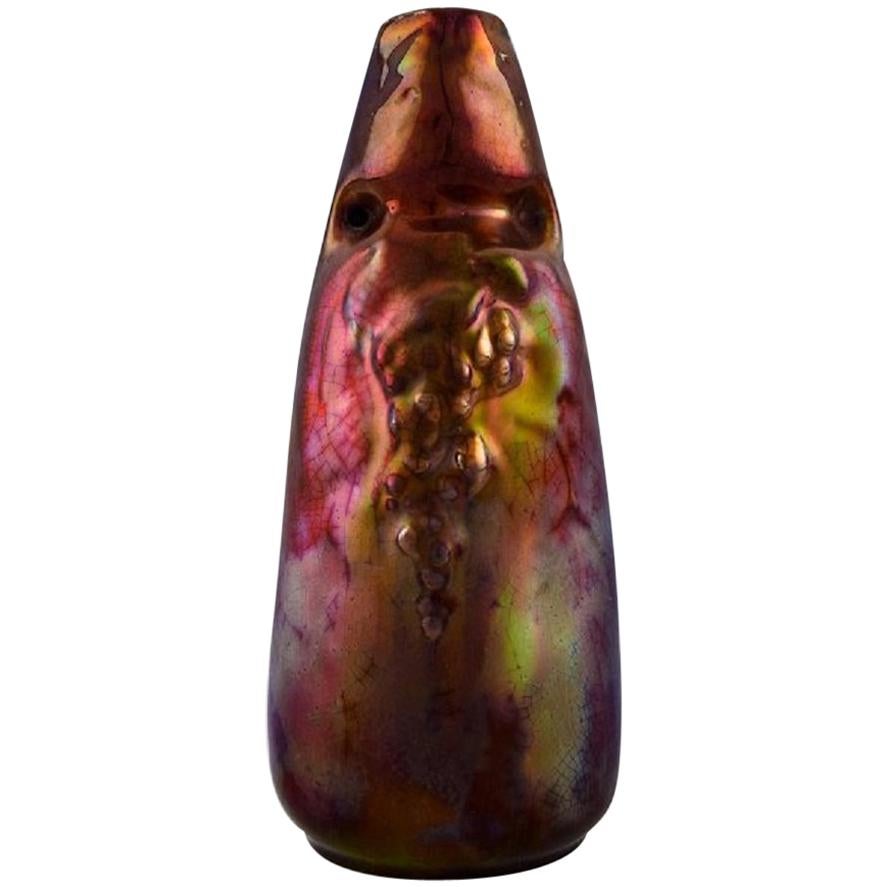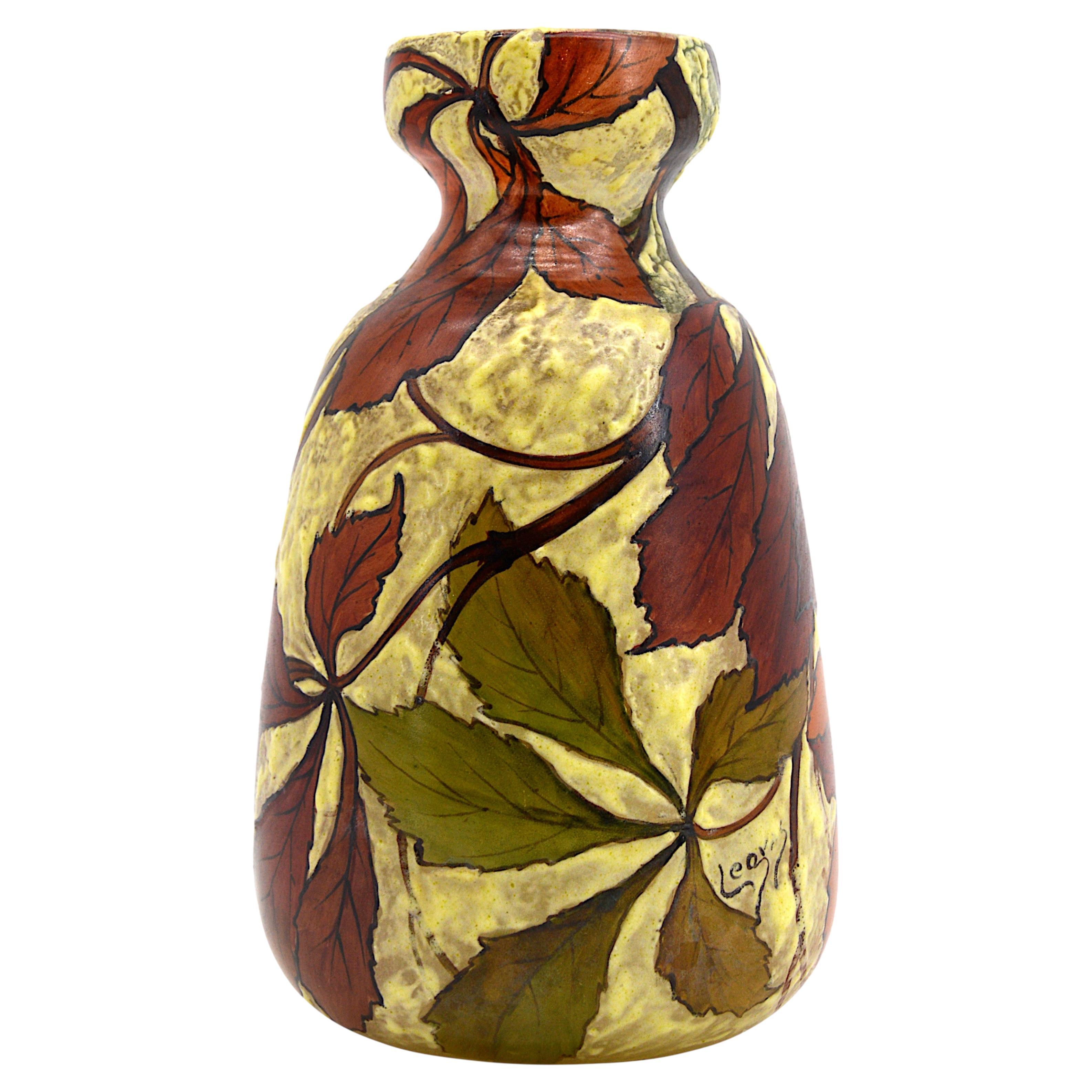Items Similar to Japanese Art Nouveau Awaji Ware Art Studio Pottery Flower Vase, ca. 1900s
Want more images or videos?
Request additional images or videos from the seller
1 of 8
Japanese Art Nouveau Awaji Ware Art Studio Pottery Flower Vase, ca. 1900s
About the Item
Japanese Art Nouveau
Flower Vase
Awaji Ware Art Studio Pottery
ca. 1900s
ABOUT AWAJI WARE ART STUDIO POTTERY
Awaji pottery was made on the Japanese island of the same name between 1830 and 1939. Most of the pieces that we see here in the West were made sometime between the mid 1870's when Awaji began exporting pottery, and the mid to late 1930's when the last of the kilns closed. Awaji pottery comes in an abundant variety of shapes, colors, and decorative techniques. The glazes are often brilliant in tone and most are translucent and finely crackled. The ware is sometimes mistaken by the uninitiated for European majolica or American art pottery. Unlike majolica and the vast majority of Western art pottery, most Awaji pottery is robustly hand-thrown, with only small and complex forms molded. Some of the earlier ware is delicately potted, but the majority of Awaji-ware is more stoutly constructed and pleasantly balanced. The Awaji potters were masters of their craft who had an innate feel for the possibilities of the clay form. The result of their efforts is a pottery of exceptionally lively forms that have an informal and genuine feel, devoid of fussiness and pretension.
The ceramic body (or paste) is made of high-fired, white or cream colored clay that borders on stoneware. The formula apparently changed over time and varied from pink or buff, to white to grey. The glazes are lead based which gives the colors brilliance and makes the translucent enamels glassy and often iridescent. The most common Awaji glaze colors are a grass green, yellow that can range from pale lemon to deep amber, cobalt blue, and aubergine (a shade of very dark purple). Other glazes are a light green, dusty blue, light and dark turquoise, mirror-black, and burgundy. The Awaji potters were adept at creating unadorned monochromes, two-tone glazes, three-color glazes (sancai), incised decoration (most commonly featuring irises), and applied relief decoration.
DIMENSIONS
Height: 9-3/4 inches
Width: 4-3/4 inches
Depth: 3-5/8 inches
- Dimensions:Height: 9.75 in (24.77 cm)Width: 4.75 in (12.07 cm)Depth: 3.63 in (9.23 cm)
- Style:Art Nouveau (Of the Period)
- Materials and Techniques:
- Place of Origin:
- Period:1900-1909
- Date of Manufacture:ca. 1900s
- Condition:Wear consistent with age and use. We make our best effort to provide a fair and descriptive condition report. Please examine photos attentively for they are an important part of the description. Send us a message to request more details or discuss price.
- Seller Location:New York, NY
- Reference Number:1stDibs: LU2819337754312
About the Seller
5.0
Vetted Seller
These experienced sellers undergo a comprehensive evaluation by our team of in-house experts.
Established in 1993
1stDibs seller since 2017
68 sales on 1stDibs
Typical response time: 2 hours
- ShippingRetrieving quote...Ships From: New York, NY
- Return PolicyA return for this item may be initiated within 10 days of delivery.
More From This SellerView All
- Japanese Art Nouveau, Awaji Ware Art Studio Pottery Flower Vase, Ca. 1900By Awaji PotteryLocated in New York, NYDIMENSIONS: Height: 12.5 inches Width: 6.75 inches Depth: 6.75 inches ABOUT AWAJI POTTERY Awaji pottery was made on the Japanese island of the same name between 1830 and 19...Category
Antique Early 1900s Japanese Art Nouveau Vases
MaterialsCeramic
- French Art Nouveau Iridescent Stoneware & Bronze Vase or Cachepot, ca. 1900sLocated in New York, NYFrench Art Nouveau Ocean Life Theme Vase Cachepot Iridescent Stoneware & Patinated Bronze Crab Appliqué ca. 1900s ABOUT We present here a most unusual and utterly decorative Fren...Category
Antique Early 1900s French Art Nouveau Vases
MaterialsStoneware
- French Art Nouveau Patinated Bronze Sculptural Iris Vase, ca. 1900Located in New York, NYABOUT IRIS The iris is a special and mysterious flower. Not only because of its striking appearance, but also from an artistic and historical point of view. It is also like a work of art, as though created by Mother Nature. The unique leaves of this plant not only create wonderful shadow casts, but also look as if they were painted by hand. It's no wonder that iris acts as the muse for countless artists, and can be seen in many famous works of art. The iris was first spotted in the time of Pharaoh Thutmose, in 1504 BC. He had the iris inscribed into the wall reliefs of a temple as a sign of his power, as well as decorating his sceptre with motifs of the flower. Since then, the iris has been a symbol of victory in Egypt. But the symbolism of the iris goes further than that. In Japan, the flower represents courage and is the symbol of the boys' festival. In Islamic cultures, the iris is a symbol of prosperity. In Europe, the flower was a popular weapon symbol in the Middle Ages and stood for chivalry. And in Christianity, the iris was seen as a symbol of the trinity because of its three-part flowers. With more than 300 varieties, the iris is now the most popular flower among growers and gardeners following the rose. Countless artists use the iris in their works and the flower is present in all eras. You can see the flower on furniture, vases, jewelry, fabrics, sculptures, coats of arms and much more. Did you know that the iris is also called the sword lily? It's not a coincidence that it used to symbolize physical and emotional pain and suffering caused by a weapon. We also see the flower in religious art, where it's often associated with Mary and Jesus. The iris is also associated with the Greek goddess Iris, where the flower symbolizes reconciliation and divine messages. This is also reflected in many paintings. Finally, the iris is also visible in Dutch and Flemish still-life paintings. This can be in a religious form, incorporated into an object or as a decorative flower. In the Art Nouveau art movement, the iris (along with other plants, such as the birch) was often used as an expression of feminine beauty. With its almost otherworldly appearance, the iris is perfectly suited to the Art Nouveau aesthetic and is featured in many well-known works of art. The poet of that era, Hermann Hesse...Category
Antique Early 1900s French Art Nouveau Planters, Cachepots and Jardinières
MaterialsBronze
- Japanese Kyoto Fuzan Satsuma Ware Double-Handled Vase, Meiji Period, ca. 1900Located in New York, NYThis beautiful end of Meiji Period Japanese Kyoto Fuzan Satsuma Ware double-handled vase has a gold plated intricate infinite circular relief pattern design and two images of goddess...Category
Antique Early 1900s Japanese Taisho Vases
MaterialsPorcelain
- Japanese Art Nouveau Meiji Period Patinated Bronze Vase, circa 1900Located in New York, NYAlthough unmarked, this rare and important, grand but at the same exquisite patinated bronze vase has just a very few little details, defying the shape of the handles, as well as the...Category
Antique Early 1900s Japanese Art Nouveau Vases
MaterialsBronze
- Charles Vital-Cornu, French Art Nouveau Bronze Sculptural Floral Vase, 1900sBy Charles Vital-CornuLocated in New York, NYCharles Vital-Cornu (French, 1851 - 1927), Jouffroy’s and Pils’ pupil, he acquired a skillfulness mastery in carving marbles and producing bronzes. He used several patinas in his production. Indeed, if his pieces' embodiments are often golden-brown colored, the hollow part are darker. His figures, hands, faces, and bodies are of a great quality. Charles Vital-Cornu had participated in numerous annual ‘‘Salons’’ organized in Paris by ‘‘la Société des Artistes Français’’ where he got several awards, such as a mention of Honor in 1880 and 1881, a third class medal in 1882, a travelling grant in 1883, a second class medal in 1886, a bronze medal at the 1889 World Fair and, finally, a silver medal at the 1900 World Fair at the Grand palace...Category
Antique Early 1900s French Art Nouveau Vases
MaterialsBronze
You May Also Like
- Flemish Studio Pottery Art Nouveau Drip Glazed Earthenware Vase 1900s Folk ArtLocated in Sherborne, DorsetThis tall and very stylish conical Art Nouveau vase is a beautiful example of Flemish pottery or ‘Poterie Flamande’ from Torhout dating from the 1900s....Category
Antique Early 1900s Belgian Art Nouveau Vases
MaterialsPottery, Earthenware
- Japanese Antique BK Paper-Covered Pottery 1860s-1900s /Flower Vase WabiSabiLocated in Sammu-shi, ChibaThis is a large Japanese pottery. It is from the Meiji period (1860s-1900s). The entire pottery is covered with paper. It comes with a wooden...Category
Early 20th Century Japanese Meiji Vases
MaterialsPottery
- Montieres Art Nouveau Iridescent Ceramic Vase, Early 1900sLocated in Copenhagen, DKMontieres Art Nouveau iridescent ceramic vase. Early 1900s. Measures: 20 cm x 9 cm. Stamped. In perfect condition.Category
Early 20th Century French Art Nouveau Vases
- Legras French Art Nouveau Enameled Vase, Early 1900sBy François-Théodore LegrasLocated in Saint-Amans-des-Cots, FRRare French Art Nouveau vase by François-Théodore Legras, France, Early 1900s. Very very rare vase with an uncommon shape showing a decor richly enamelled with chestnut leaves. A mus...Category
Antique Early 1900s French Art Nouveau Glass
MaterialsArt Glass
- 1900s Pair of Art Nouveau Ceramic Neapolitan VasesBy Guido CacciapuotiLocated in Catania, SiciliaTwo rare Art Nouveau ceramic vases made in Italy in 1900. They depicting two children playing. Signs of use and age visible on the photos.Category
Antique Early 1900s Italian Art Nouveau Vases
MaterialsCeramic
- 20th Century Blue French Pierrefonds Pottery Flower Vase, 1900sBy Pierrefonds PotteryLocated in Buenos Aires, OlivosArt Nouveau Pierrefonds pottery vase in tones of blue, tan and brown, partially decorated in crystalline glazes, stamped factory marks. France, circa 1900.Category
Early 20th Century French Art Nouveau Pottery
MaterialsPottery
Recently Viewed
View AllMore Ways To Browse
Yellow Awaji
Japan Glazed Blue Vase
Amber Ceramic Vase
Dark Blue And White Vase
Japanese Purple Vase
Japanese Crackle Pottery
Japanese Export Blue And White
Shade Vessel Ceramic
Japanese Awaji Pottery
Japan Made Monochrome Vases
Climbing Frog
Opaline Vase England
Vase Japonais
Green Sea Glass Vase With Gold
Vaso A Coppa
Painted Ceramic Art
Blown Glass Vessel
Large Blown Glass Vessel





